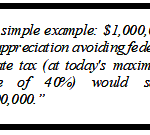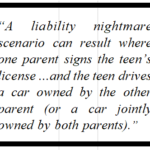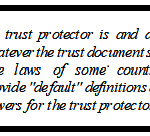The Importance of Proper Asset Protection Design
Volume VII, Number 2 – October 1998
THE IMPORTANCE OF PROPER APT DESIGN & COUNSEL
It Does Make A Difference!
INTRODUCTION.
In this issue we will examine the importance of proper design of the asset protection trust, and, integrally related to proper trust design, the importance of competent, experienced counsel. We’re sure you have all heard the expression, “bad facts make bad law”. That is the unfortunate circumstance of Mr. and Mrs. Anderson. Adding insult to injury, incompetent or inexperienced counsel can make matters even worse.
BACKGROUND.
Here’s what happened: The Andersons established a Cook Islands trust, naming themselves as co-trustees and trust protectors. We are not privy to the advice given to the Andersons, but we were surprised the Andersons’ lawyer did not dissuade them from acting as both co-trustees and as trust protectors. The Andersons’ telemarketing companies generated millions of dollars in commissions from selling investments in late-night television commercials for a company called Sterling Group. The Sterling Group was charged with criminal fraud by Nevada and with civil fraud by the FTC. Assets were being seized anywhere they could be found from all parties involved in the promotion.
The Andersons had transferred a substantial portion of the commissions they earned into their Cook Islands trust. The federal judge ordered the Andersons to repatriate those funds, and, complying with the order, the Andersons requested the Cook Islands co-trustee to send the money back to the United States. However, in their request to the Cook Islands trustee, they mentioned that the request was a result of a court order. Under the trust instrument, the Andersons were automatically removed as trustees upon becoming subject to a court order. The Cook Islands trustee, further complying with the provisions of the trust instrument and with Cook Islands law, refused to send the funds back to United States. When the funds weren’t repatriated as ordered, the federal judge held the Andersons in contempt of court and sent them to jail.
We personally conferred with the Cook Islands trustee during our recent trip to the Cook Islands. The Cook Islands trustee acted properly and in accordance with the direction of the Cook Islands court, given the mandate of the trust document and Cook Islands (governing) law. There was no other course of action which the Cook Islands trustee could have taken. The result: the assets will be protected, but the Andersons may remain in jail for some time.

What went wrong here? A combination of things: a poorly crafted trust instrument along with a lack of proper legal counsel. What lessons can be learned from this case? What caused the judge to hold the Andersons in contempt? Let’s back up a moment and take a look at what the law requires in order for a judge to hold you in contempt of court. The best defense to a contempt of court threat is “impossibility of performance”. The United States Supreme Court has ruled that you cannot be held in contempt of court for failing to comply with a court order which is impossible for you to perform, even if you created the impossibility. An exception to that rule is if you created the impossibility close to the time of your being ordered to perform. This is what happened in the Anderson case. How so? The Andersons (who should never have been trustees in the first place) served as co-trustees until the time a temporary restraining order was issued. As trustees, they had the legal authority to deal with trust assets. Thus, at the time the judge issued the temporary restraining order, the Andersons were legally able to deal with trust assets, but the impossibility was then created – pretty late in the game.
PROPER TRUST DESIGN.
Let’s talk about proper trust design. First, it is important that the settlor of the trust not serve as a trustee, since the trustee (as mentioned above) has the power to deal with trust assets. In addition, the trust should provide that the settlor cannot be appointed as trustee (we have been involved in cases where this was a critical factor in successfully defending a contempt threat). This should preclude any argument that the settlor can obtain trustee powers (and, consequently, control of trust assets) at any time (now or in the future). What about the fact that the Andersons served as trust protectors?
Asset protection practitioners differ on this point. The conservative view would preclude the settlor from serving as trust protector, but it may not be necessary to be that conservative, unless a problem is looming in the future. The information available at this time does not reveal all the powers the Andersons had as trust protectors under their trust (they did have the power to appoint trustees), but any well-designed asset protection trust would only give the trust protector (whoever that might be) the power to veto (not order) any discretionary acts the trustee might want to take. In addition, the trust protector would ordinarily have the power to remove and replace any trustee with or without cause. All powers held by the trust protector (and any other non-trustee person in whatever capacity) must be subject to a “duress provision”.
In essence, a duress provision nullifies the effective exercise of any power held by any person unless that power is being exercised by that person of their own free will. Some trusts are designed with the hope that the trustee will know that a power is being exercised under duress because some reference to a court order will be made in a communication to the offshore trustee. However, a properly designed trust will contain a mechanism by which the trustee will know that duress exists, even if the court orders the power holder not to mention the court action. The trusts that we have reviewed (prepared by other practitioners) do not contain such a mechanism.
Other design considerations include only having the settlor retain limited powers of appointment. That is, power to direct the distribution of trust assets outright only to persons other than the settlor, the settlor’s spouse, and their creditors.
A carefully drafted “flight clause” is a very important provision in any offshore trust. Not only does such a clause have asset protection consequences, but it may also have U.S. income tax ramifications. A flight clause is a trust provision which enables a trust to “move” to another country if threatened in its situs jurisdiction (by litigation, government unrest, etc.). Not having the Andersons’ trust instrument available for our review, we cannot comment on the type (if any) of the “flight clause” contained in the trust. A properly designed flight clause will be coordinated with an independent mechanism in the trust for transferring the title of trust assets from an old trustee to a new trustee.
In this context, an “independent mechanism” means a mechanism which will facilitate the change of title without the need for the involvement of the outgoing trustee. This way, if something were to happen to a trustee (restraining order, death, etc.) trust assets will not be affected. We have seen no trusts (other than ours) which contain such a crucial mechanism. The foregoing discussion of trust design elements is not intended to be all-inclusive by any means.
COMPETENT, EXPERIENCED COUNSEL.
Can you have a properly designed asset protection trust without competent, experienced counsel? Possibly – one could obtain a trust document from someone who did retain competent counsel. However, competent advice regarding the implementation and operation of the trust is just as crucial as a properly designed trust document. Perhaps the Andersons should have been advised to resign as trustees and as protectors as soon as trouble arose.
CONCLUSION.
Of real concern is the proliferation of asset protection services enticingly marketed on the internet and elsewhere. Most are not offered by attorneys, and even some that are offered by attorneys are offered by attorneys who do not have a tax background (which is essential in offshore trust planning). Competent, experienced counsel is the key to effective protection.
Donlevy-Rosen & Rosen, P.A. is law firm with a national practice focused on asset protection planning and offshore trusts. Attorneys Howard Rosen and Patricia Donlevy-Rosen co-founded the firm in 1991, and have since become internationally recognized authorities in the field of asset protection planning. Send a message using our contact page



















Connect
Connect with us on the following social media platforms.